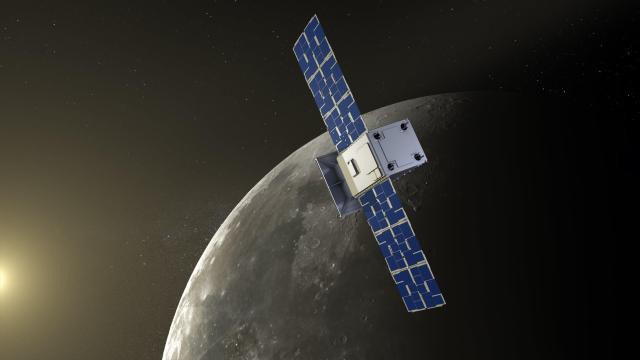After going MIA for nearly 24 hours, NASA’s CAPSTONE probe finally reestablished contact with ground controllers. The microwave-sized satellite is currently en route to the Moon where it will test a unique orbital configuration for an upcoming lunar space station.
Ground controllers successfully restored communication with the spacecraft on Wednesday at 9:26 a.m. ET, when the operations team began receiving signals from CAPSTONE, according to Advanced Space, the Colorado-based company which operates the mission for NASA. Approximately one hour later, the team was able to confirm that the spacecraft was healthy and functioning normally. While it was silent, CAPSTONE autonomously performed some tasks, such as maintaining its battery charge, staying pointed in the right direction, and even performing a manoeuvre to get rid of excess momentum.
The team believes that CAPSTONE is ready for its first trajectory correction manoeuvre, one of several planned gravitational contours that’s set to send the spacecraft towards its unique elliptical orbit around the Moon. The team is preparing for the manoeuvre as early as 11:30 a.m. ET on Thursday.
NASA is still not sure what caused CAPSTONE to drop its communications line with the agency’s Deep Space Network, an array of giant radio antennas that helps NASA stay in contact with its spacecraft. “Ground-based testing suggests the issue was triggered during commissioning activities of the communications system,” NASA wrote in a blog post. “The team will continue to evaluate the data leading up to the communications issue and monitor CAPSTONE’s status.”
CAPSTONE launched on June 28 on board a Rocket Lab Electron rocket. Shortly after exiting Earth’s orbit to begin its trip towards the Moon, the spacecraft suddenly stopped sending signals to the mission team. The 55-pound (25 kilograms) cubesat is on a ballistic lunar transfer trajectory to the Moon, travelling through a series of gravitational loops to reduce the amount of fuel needed to reach its destination. The probe is scheduled to enter into a near rectilinear halo orbit (NRHO) around the Moon on November 13. This gravitationally stable orbit should be ideal for NASA’s future Lunar Gateway (a small space station that will be placed in lunar orbit later this decade in support of the Artemis program), but the CAPSTONE mission will test this out in practice.
Despite the mission team not knowing the exact cause of the communications anomaly, the mission does seem to be proceeding as planned. “The team has high confidence that the issue has been cleared and through changes to the configuration and operations it will not happen again,” Advanced Space wrote in a statement.
Let’s hope the company is right. Those upcoming gravitational manoeuvres will be exceptionally difficult — if not impossible — for the spacecraft to pull off on its own.
More: The coolest images taken by NASA’s New Horizons spacecraft.
